Stable expression of human beta1,4-galactosyltransferase in plant cells modifies N-linked glycosylation patterns
- PMID: 10200324
- PMCID: PMC16394
- DOI: 10.1073/pnas.96.8.4692
Stable expression of human beta1,4-galactosyltransferase in plant cells modifies N-linked glycosylation patterns
Abstract
beta1,4-Galactosyltransferase (UDP galactose: beta-N-acetylglucosaminide: beta1,4-galactosyltransferase; EC 2.4.1. 22) catalyzes the transfer of galactose from UDP-Gal to N-acetylglucosamine in the penultimate stages of the terminal glycosylation of N-linked complex oligosaccharides in mammalian cells. Tobacco BY2 cells lack this Golgi enzyme. To determine to what extent the production of a mammalian glycosyltransferase can alter the glycosylation pathway of plant cells, tobacco BY2 suspension-cultured cells were stably transformed with the full-length human galactosyltransferase gene placed under the control of the cauliflower mosaic virus 35S promoter. The expression was confirmed by assaying enzymatic activity as well as by Southern and Western blotting. The transformant with the highest level of enzymatic activity has glycans with galactose residues at the terminal nonreducing ends, indicating the successful modification of the plant cell N-glycosylation pathway. Analysis of the oligosaccharide structures shows that the galactosylated N-glycans account for 47.3% of the total sugar chains. In addition, the absence of the dominant xylosidated- and fucosylated-type sugar chains confirms that the transformed cells can be used to produce glycoproteins without the highly immunogenic glycans typically found in plants. These results demonstrate the synthesis in plants of N-linked glycans with modified and defined sugar chain structures similar to mammalian glycoproteins.
Figures
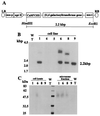

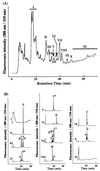
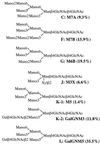
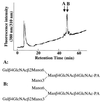
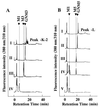
Similar articles
-
Galactose-extended glycans of antibodies produced by transgenic plants.Proc Natl Acad Sci U S A. 2001 Feb 27;98(5):2899-904. doi: 10.1073/pnas.031419998. Proc Natl Acad Sci U S A. 2001. PMID: 11226338 Free PMC article.
-
Production of mouse monoclonal antibody with galactose-extended sugar chain by suspension cultured tobacco BY2 cells expressing human beta(1,4)-galactosyltransferase.Biochem Biophys Res Commun. 2007 Jun 22;358(1):85-91. doi: 10.1016/j.bbrc.2007.04.054. Epub 2007 Apr 19. Biochem Biophys Res Commun. 2007. PMID: 17481579
-
Ammonium alters N-glycan structures of recombinant TNFR-IgG: degradative versus biosynthetic mechanisms.Biotechnol Bioeng. 2000 Jun 20;68(6):637-46. doi: 10.1002/(sici)1097-0290(20000620)68:6<637::aid-bit6>3.0.co;2-c. Biotechnol Bioeng. 2000. PMID: 10799988
-
N-glycosylation engineering of biopharmaceutical expression systems.Curr Mol Med. 2009 Sep;9(7):774-800. doi: 10.2174/156652409789105552. Curr Mol Med. 2009. PMID: 19860659 Review.
-
Beta 1,4-galactosyltransferase variations in rheumatoid arthritis.Adv Exp Med Biol. 1995;376:185-92. doi: 10.1007/978-1-4615-1885-3_19. Adv Exp Med Biol. 1995. PMID: 8597247 Review.
Cited by
-
N-Glycosylation of an IgG antibody secreted by Nicotiana tabacum BY-2 cells can be modulated through co-expression of human β-1,4-galactosyltransferase.Transgenic Res. 2017 Jun;26(3):375-384. doi: 10.1007/s11248-017-0013-6. Epub 2017 Mar 22. Transgenic Res. 2017. PMID: 28332009
-
Plant glyco-biotechnology on the way to synthetic biology.Front Plant Sci. 2014 Oct 8;5:523. doi: 10.3389/fpls.2014.00523. eCollection 2014. Front Plant Sci. 2014. PMID: 25339965 Free PMC article. Review.
-
Beta-N-acetylhexosaminidases HEXO1 and HEXO3 are responsible for the formation of paucimannosidic N-glycans in Arabidopsis thaliana.J Biol Chem. 2011 Mar 25;286(12):10793-802. doi: 10.1074/jbc.M110.178020. Epub 2011 Jan 20. J Biol Chem. 2011. PMID: 21252225 Free PMC article.
-
N-Glycosylation engineering of tobacco plants to produce asialoerythropoietin.Plant Cell Rep. 2012 Jul;31(7):1233-43. doi: 10.1007/s00299-012-1244-x. Epub 2012 Feb 28. Plant Cell Rep. 2012. PMID: 22371257
-
Galactose-extended glycans of antibodies produced by transgenic plants.Proc Natl Acad Sci U S A. 2001 Feb 27;98(5):2899-904. doi: 10.1073/pnas.031419998. Proc Natl Acad Sci U S A. 2001. PMID: 11226338 Free PMC article.
References
-
- Cramer C L, Weissenborn D L, Oishi K K, Grabau E A, Bennett S, Ponce E, Grabowski G A, Radin D N. Ann N Y Acad Sci. 1996;792:62–71. - PubMed
-
- Kusnadi A R, Nikolov Z L, Howard J A. Biotechnol Bioeng. 1997;56:473–484. - PubMed
-
- Arntzen C J. Nat Biotechnol. 1997;15:221–222. - PubMed
-
- Pen J. In: Transgenic Plants: A Production System for Industrial and Pharmaceutical Proteins. Owen M R L, Pen J, editors. New York: Wiley; 1996. pp. 149–167.
-
- Kukuruzinska M A, Lennon K. Crit Rev Oral Biol Med. 1998;9:415–448. - PubMed
MeSH terms
Substances
LinkOut - more resources
Full Text Sources
Other Literature Sources

